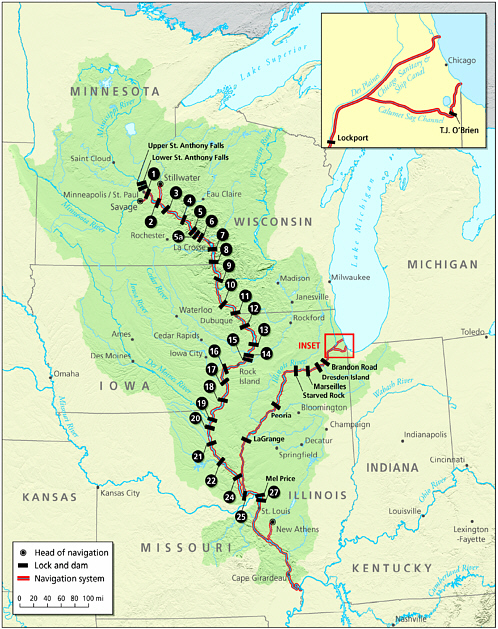1
Introduction
For well over one hundred years the U.S. Army Corps of Engineers has been responsible for the construction, operation, and maintenance of a major inland waterway system on the Upper Mississippi River (UMR) and the various waterbodies in the State of Illinois that make up the Illinois Waterway (IWW). The UMR-IWW Navigation Project presently uses 35 dams to maintain a navigation channel of at least 9 feet in depth throughout the system; locks are provided at 37 sites, 29 on the UMR and 8 on the IWW (see Figure 1.1). Much of the existing infrastructure was constructed in the 1930s, pursuant to the 1930 Rivers and Harbors Act that authorized a 9-foot channel project for the Upper Mississippi River.
Waterway congestion and the rehabilitation of UMR-IWW locks and dams are issues that date back several decades. For instance, the Corps was studying possibilities for improvements to Upper Mississippi River locks and dams in the 1960s. Waterway traffic congestion at Lock and Dam 26, near Alton, Illinois, led to a recommendation for a new dam with a 1,200-foot lock chamber. This facility, which was renamed Melvin Price Lock and Dam, was completed in 1990. By the late 1980s, however, waterway traffic congestion at other downstream locks and on the Illinois Waterway prompted the Corps to begin evaluating the feasibility of extending other lock chambers from 600 to 1,200 feet in length. This construction was proposed to reduce lockage times by allowing the largest tows (typically consisting of 15 barges plus a towboat) to be processed in a single lockage. The Corps’ formal feasibility study of the UMR-IWW began in 1993 and was completed in 2004. The various studies that were conducted as part of this effort were in many ways unprecedented in scope, approaches employed, and in their analytical complexities. As the overall feasibility study progressed, two successive committees of the National Research Council (NRC) were convened to provide independent advice on the feasibility study’s various technical aspects.
The first, or Phase I, committee was convened in 2000 and issued a single report in 2001. At that time the feasibility study was solely concerned with navigation improvements. Subsequent to the issue of the 2001 report, the Corps restructured the feasibility study, leading to a broader and significantly more complex study. Among the major changes was the addition of ecosystem restoration as a second project objective. After resuming work on the restructured feasibility study, the Corps requested the National Research Council to convene a second committee to review technical aspects of the ongoing study. The second, or Phase II, committee began its activities in 2003, issuing two reports in 2004 (NRC, 2004a,b). This is the third and final report from the Phase II committee. This committee’s first two reports focused on the ecologic, economic, and engineering aspects of the Corps feasibility study. The charge to the committee was the same for each of these 2004 reports.
This third report is guided by a statement of task that assumes a broader perspective on Corps of Engineers planning and management of UMR-IWW resources (see Box 1.1). Although this report’s perspective thus differs from the committee’s first two reports, those two reports constitute important background for this third report, and they should be consulted by those seeking deeper understanding of the Corps feasibility study and UMR-IWW management issues such as waterway system management and forecasting, spatial modeling of global and regional grain markets, and ecosystem restoration.
In addition to this committee’s two 2004 reports this report builds upon other National Research Council studies. Specifically, the statement of task in Box 1.1 of this report called for the Corps UMR-IWW feasibility study to be considered in the context of the National Research Council’s “216” studies. This set of studies, most of which were completed in 2004, were conducted pursuant to Section 216 of the federal Water Resources Development Act (WRDA) of 2000, which requested the NRC to review Corps of Engineers peer review procedures and methods of analysis (Section 216 from WRDA 2000 is reproduced in Appendix A). In response to that congressional directive the NRC convened four separate committees and the Coordinating Committee that followed progress of the individual panels. These five groups issued reports on the topics of:
-
Peer review (NRC, 2002);
-
Adaptive management (NRC, 2004c);
-
Analytical methods (NRC, 2004d);
-
River basin and coastal systems (NRC, 2004e); and
-
Coordinating Committee (NRC, 2004f).
|
BOX 1.1 Third Report Statement of Task The nature of this committee’s third and final report will differ from its first two reports. This committee’s first two reports focused on reviewing the analyses performed within the Corps Restructured feasibility study for the Upper Mississippi River-Illinois Waterway. This third report will consider several larger issues that affect the conduct of the feasibility study and that affect UMR-IWW system management. The committee may issue additional comments on the Corps feasibility study, but the report’s emphasis will be on the following (and perhaps other) larger issues:
|
Chapter 2 of this report summarizes the 216 study activity and its five reports. Chapter 3 builds upon the topics presented in Chapter 2 and comments on key 216 study findings and their application to the UMR-IWW feasibility study and system management. Consistent with this committee’s statement of task, Chapter 3 discusses the topics of adaptive management and valuation of environmental benefits, along with other topics and reports relevant to UMR-IWW resources management. The report concludes with a short epilogue presented as Chapter 4.





